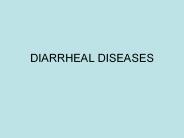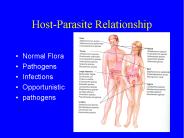Enterotoxin PowerPoint PPT Presentations
All Time
Recommended
Numerous endemic food poisoning incidents. Exact numbers not known. Most cases are not reported ... Follow FDA/USDA guidelines for proper handling of food ...
| PowerPoint PPT presentation | free to download
EXOTOXINS CYTOTOXINS NEUROTOXINS ENTEROTOXINS Enterotoxins. A number of bacteria produce exotoxins that bind to the cells of the small intestines.
| PowerPoint PPT presentation | free to view
Enterotoxins (acute intestinal sx's; food poisoning) Contamination of food, Staph. aureus secretes enterotoxin; ingestion causes food poisoning. ...
| PowerPoint PPT presentation | free to view
DIARRHEAL DISEASES Defence mechanisms Gastric acidity GI peristalsis Normal flora Immune defences Pathogenesis of diarrhea Villous damage Enterotoxin Cytotoxin ...
| PowerPoint PPT presentation | free to download
malabsorption of food (mucosal injury, lactase deficiency) Secretory diarrhea ... Enterotoxins: Cholera, E. coli, food poisoning, Rotavirus (?), Norwalk virus ...
| PowerPoint PPT presentation | free to view
rice, spices, meat, eggs, dairy products. enterotoxin 3 enterotoxins ... most often associated with fried rice. Chinese restaurants common source ...
| PowerPoint PPT presentation | free to view
Cholera toxin. Membrane Activity -A1 subunit of cholera ADP-ribosylates a ... Cholera toxin. E. coli Heat Stable enterotoxin. Heat-stable enterotoxin a (STa) ...
| PowerPoint PPT presentation | free to view
Diarrhea: noninflammatory and inflammatory. Enteropathogens elicit noninflammatory diarrhea through enterotoxin production by some bacteria, destruction of villus (surface) cells by viruses, adherence by parasites, and adherence and/or translocation by bacteria.
| PowerPoint PPT presentation | free to download
Or TAUN in Bahasa Malaysia By Razeen and Zulhisyam Cholera, sometimes known as Asiatic or epidemic cholera, is an infectiousgastroenteritis caused by enterotoxin ...
| PowerPoint PPT presentation | free to download
Enteric pathogen bacteria Enterobacteriaceae Gram negative Exotoxin enterotoxin Endotoxin in cell walls(LPS) Antigens 3 major groups of antigens: Somatic O ...
| PowerPoint PPT presentation | free to download
E. coli strain implicated in dysentery-like infection with fevers ... Campylobacter acute enteritis, usually bloody diarrhea, have enterotoxin ...
| PowerPoint PPT presentation | free to view
Bacterial (gastro-)enteritis: organism causes disease, not exotoxin ... Many other organisms produce enterotoxins (E. coli, Campylobacter, etc. ...
| PowerPoint PPT presentation | free to view
Food Microbiology Spoilage Preservation Acidity Canning Chemical Preservation Drying Irradiation Food Poisoning Intoxication Staphylococcus aureus Enterotoxin ...
| PowerPoint PPT presentation | free to download
food poisoning/enterotoxins. toxic shock syndrome. toxic shock toxin ... Food poisoning. Vomiting. nausea. diarrhea. abdominal pain. Associated with outbreak ...
| PowerPoint PPT presentation | free to view
Food poisoning due to Staphylococcus aureus is an enterotoxin ... Salts secreted on skin inhibits most except Staph epidermidis and Staph aureus ...
| PowerPoint PPT presentation | free to view
Protein A: A Major Protien in the Cell Wall 2. Enterotoxins: Immunologic Types A-E. 3. a ... Food Poisoning : 8. Toxic Shock ... A Major Protien in the Cell ...
| PowerPoint PPT presentation | free to view
intestines caused by viruses, bacteria or their toxins and ... Heat labile enterotoxin causes inhibition of Na reabsorbtion through adenyl cyclase activation ...
| PowerPoint PPT presentation | free to view
Amber Smith. What is Cholera? Acute intestinal infection caused by. Vibrio Cholerae. Produces enterotoxin, causes diarrhea & death by dehydration ...
| PowerPoint PPT presentation | free to view
What is pseudomembranous colitis? -severe irritation of the colon ... involved in development of colitis -toxin A enterotoxin. Toxin B (cytotoxin) ...
| PowerPoint PPT presentation | free to download
food poisoning/enterotoxins. toxic shock syndrome. toxic shock toxin ... Food poisoning. Vomiting. nausea. diarrhea. abdominal pain. 20. Associated with outbreak ...
| PowerPoint PPT presentation | free to view
some strains produce enterotoxin like E.coli. Diseases. nosocomial UTI - 5 ... acute infectious enteritis. syndrome: frequent, small volume bloody stool ...
| PowerPoint PPT presentation | free to view
Staphylococcal Food Poisoning: Enterotoxin is produced in improperly stored foods when Staph. aureus in introduced into foods and allowed to grow at room temperature ...
| PowerPoint PPT presentation | free to view
Plant vaccines contain dead or weakened strains of plant virus which are ... E.coli heat-labile enterotoxin B subunit (LT-B) in tobacco & potato ...
| PowerPoint PPT presentation | free to view
The fig plant & fig wasp symbiosis is basically mutualistic ... than one day to five days, and produces an enterotoxin that causes a copious, ...
| PowerPoint PPT presentation | free to view
Chapter 14 Add-on How Bacterial Cells Damage Host Cells Three mechanisms: Direct Damage Toxins* Hypersensitivity Reactions * Most bacterial damage is carried out by ...
| PowerPoint PPT presentation | free to download
FAMILY: VIBRIONACEAE Prof. Khalifa Sifaw Ghenghesh 3 Important Genera: Vibrio Aeromonas, Plesiomonas Oxidase +ve Habitat ...
| PowerPoint PPT presentation | free to view
The link between staphylococci and foodborne illness was made 1914 when ... Glycine betaine is the most important osmoprotectant ...
| PowerPoint PPT presentation | free to view
Title: Biological Products/Agents and Their Impact on Human Cells, Tissue and Their Related Diseases Author: oo Last modified by: personal computer
| PowerPoint PPT presentation | free to download
Enteric Bacteria Prof. Dr. Asem Shehabi Faculty of Medicine University of Jordan
| PowerPoint PPT presentation | free to download
The Jordan University-Faculty of Medicine Gram-Positive Bacilli Prof. Dr. Asem Shehabi and Dr. Suzan Matar Corynebacteria Group Gram-positive Pleomorphic Bacilli..
| PowerPoint PPT presentation | free to download
Title: Aucun titre de diapositive Author: U452 Last modified by: doyen Created Date: 12/8/2001 10:35:42 AM Document presentation format: Affichage l' cran
| PowerPoint PPT presentation | free to download
Title: Author: Lanter Last modified by: Wonghc Created Date: 1/17/2006 4:50:51 PM Document presentation format: Company
| PowerPoint PPT presentation | free to view
First pandemic spreads from India to South, Central Asia, Middle East and Russia ... Bury St Edmunds, Great Britain: Chapman & Hall (1996) ...
| PowerPoint PPT presentation | free to view
Gram pos. Erreger: Bedeutung der Virulenzfaktoren Robert Krause
| PowerPoint PPT presentation | free to download
Host-Parasite Relationship Normal Flora Pathogens Infections Opportunistic pathogens Skin Flora 180 species Streptococcus Staphylococcus Propionibacterium Body Odor ...
| PowerPoint PPT presentation | free to download
Presentation:fever, malaise, abd.pain diarrhea blood. Diagnosis: stool microscopy & culture ... Diagnosis: stool culture. Treatment: fluids antibiotic ...
| PowerPoint PPT presentation | free to view
Title: Chapter 16 - Enterobacteriaceae Author: Instructional Technology Last modified by: kbrophym Created Date: 7/14/2005 5:59:43 PM Document presentation format
| PowerPoint PPT presentation | free to view
1998 - Vibrio parahaemolyticus 1993 - Cryptosporidium GI Infectious ... secretory Vibrio cholera, enterotoxigenic E.coli Inflammatory ...
| PowerPoint PPT presentation | free to download
CHOLERA Vibrio cholerae Brenda Anna Kwambana Wangeci Kagucia History Origins in India, cases reported as early as 1563 About 8 pandemics to date 1817-`23: First ...
| PowerPoint PPT presentation | free to download
B 2/24 (8) C 0/24 (0) D 1/24 (4) E 2/24 (8) total 8/120 (6.7) ... Generation and lag time. Phenotyping. Biochemical 3 biotypes. Antibiograms 4 antibiograms ...
| PowerPoint PPT presentation | free to view
Vibrio and Aeromonas Gram-negative Falcultatively anaerobic Fermentative rods Positive oxidase reaction Polar flagella
| PowerPoint PPT presentation | free to download
In investigating an outbreak, speed is essential, but getting the right answer ... both requirements, epidemiologists approach investigations systematically, ...
| PowerPoint PPT presentation | free to view
Anaerobic, Spore-forming, Gram-Positive Rods Clostridium - anaerobic, gram-positive rods capable of forming endospores (1) presence of endospores, (2) strict ...
| PowerPoint PPT presentation | free to download
... high risk groups should avoid the food listed above and reheat and refrigerated leftovers Clostridium perfringens Problem with ... cream based desserts, ...
| PowerPoint PPT presentation | free to view
... Transmission Vibrio cholerae Epidemiology Epidemic cholera-spread by contaminated water under conditions of poor sanitation Endemic-consumption of raw seafood ...
| PowerPoint PPT presentation | free to view
Antigenic variants LT-I and LT-II. LT-I neutralised by anti-cholera toxin ... Used as mucosal adjuvant. LT holotoxin secreted to periplasmic space ...
| PowerPoint PPT presentation | free to view
SALMONELLA Salmonella is a Gram-negative facultative rod-shaped bacterium belonging to family Enterobacteriaceae, Salmonellae live in the intestinal tracts of warm ...
| PowerPoint PPT presentation | free to download
Mannitol egg yolk polymyxin agar (MYP) is usually recommended. ... HBL produces a unique discontinuous hemolysis pattern on blood agar. ...
| PowerPoint PPT presentation | free to view
direct damage in the immediate vicinity. grow & multiply ... scarlet fever/scarlatina. lysogenized bacteriophage codes for toxin. mechanisms of pathogenicity ...
| PowerPoint PPT presentation | free to view
Pathogenesis - the course of the disease; development. Disease pathology - changes in the body ... PLASMIDS & BACTERIOPHAGE. plasmids: botulism, coagulase ...
| PowerPoint PPT presentation | free to view
Anaerobic, Spore-forming, Gram-Positive Rods Clostridium - anaerobic, gram-positive rods capable of forming endospores (1) presence of ...
| PowerPoint PPT presentation | free to download
animal cattle, pigs, chickens, turkeys - food mainly cooked foods ... baked ham, chicken salad, hot turkey. sandwiches, lasagna pasta. VPH & MH 116.407. 19 ...
| PowerPoint PPT presentation | free to view
... and identify the causative agents in a simulated urine culture and stool culture ... Blood. Stool culture plates. EMB. MAC. TSA. Blood. MSA. Urine cultures ...
| PowerPoint PPT presentation | free to view
Yersinia Summary Table REVIEW Yersinia Summary Table (cont.) REVIEW Yersinia pestis Clinical Forms of Plague (a.k.a., Black Death): Bubonic plague with swollen and ...
| PowerPoint PPT presentation | free to download
Title: Sn mek 1 Author: Peter Kluson Last modified by: Petr Z mostn Created Date: 10/1/2003 10:50:14 PM Document presentation format: P edv d n na obrazovce
| PowerPoint PPT presentation | free to download
Stool exam: blood in 60%, PMNs in 78% Usually self-limited. Yersinia enterocolitica ... fever, nausea, vomiting, blood in stool; often associated with ...
| PowerPoint PPT presentation | free to view
























































